
This is the story of a diamond whose beginnings and early history are unknown, a casualty of lost or poor documentation. It owes its impressive size to an owner whose blessed foresight – or perhaps stubbornness – to ignore professional advice allowed the stone to fulfill its destiny as one large diamond instead of being cut into two smaller ones. While it has been coveted by the royal families of two nations, at various times throughout its history, been known by three different names and displayed in numerous settings, its beauty has remained unchanged. It is the Holland Diamond.
Across the channel, in England, the Glorious Revolution had succeeded in removing James II from the English throne. Although the English crown belonged to Mary, it was her husband William who – with his wife’s support – set off for England to claim the throne for himself. After the success of their campaign, William III, and Mary II were – in an unprecedented move – crowned in 1689 as King and Queen of England. This is the only time in English history that the country has been ruled by joint sovereigns with equal power (usually the spouse is a powerless consort.) Even though Mary yielded most of her powers to her husband, he relied heavily on her and she served ably as sovereign ruler during his many and protracted absences from England.
The Holland Diamond’s first documented owner was the future Queen of England, Mary II. Born in April of 1662, Mary was the eldest daughter of James, Duke of York and the future King James II of England. When Mary came of age her important status as heir to the throne of England required a proper marriage, so a search for a husband began. Enter William, Prince of Orange and Mary’s first cousin, who filled the needs of a husband who could offer a political and religious alliance to Mary and to England. Moving to the Netherlands to live with her new husband, Mary became a popular figure with the Dutch people. However, their time in the Netherlands would not be long as events in 1688 changed their lives forever.

It was sometime after their marriage that William and Mary purchased a large uncut diamond. Ignoring the advice of the seller to have the stone cut into two smaller diamonds, Queen Mary ordered the rough diamond be cut as one stone. There is debate as to where the work was done, but Amsterdam would be the logical guess since – at that time – it was the cutting center for Europe. The result of the cutting was a rose-cut diamond. This diamond, now known as the “Stuart,” after its owner, became the center stone in a large brooch.
Queen Mary II would enjoy the diamond until 1694 when an outbreak of smallpox claimed her life at age 32. Because Mary and William were childless, all of her possessions, including her jewelry, went to her husband. When the widowed William died in 1702 the jewelry was inventoried and, since most of it was originally the property of the House of Orange, it was returned to the Netherlands. This included the “Stuart” Diamond.
Taking exception to this decision was Mary’s sister Anne, next in line to the throne of England. Believing William’s jewelry should remain in England, Anne sued for ownership of any item purchased by William and Mary after their marriage. However, her suit came too late to regain any of the jewelry already returned to the House of Orange.
Feeling pressure to maintain guardianship over the treasures of the House of Orange – including the “Stuart” Diamond – Dutch Stadholder, Prince Willem V had a contract drawn up in 1782 stating that none of the jewelry could be sold without the permission of all the members of the House of Orange. Years later, in a twist of fate, the House of Orange diamond collection returned to England when Prince Willem V, his wife Princess Wilhelmina, and his family sought asylum there, escaping the invasion of their country by the French army.

With the House of Orange now residing in exile across the English Channel, Princess Wilhelmina was introduced to the British jewelers Rundell & Bridge by Queen Charlotte. The Dutch Princess had several items of the family’s jewelry redesigned by them, including resetting Queen Mary’s rose-cut into a pendant suspended from a necklace. It’s at this time the stone is weighed and found to be 39.75 carats. It’s also during this time that the diamond is now referred to as the “Holland”. Perhaps this name change was an effort by the House of Orange to sever the diamond’s past relationship with England. The diamond also picked up yet another nickname in 1851, when, during the Great Exhibition, the “Holland” was described as being “of the purest water”1 and weighing 36 carats, and was briefly referred to as the “Cone” diamond.
Once it was safe for the Dutch royals to return to their home Willem VI became sovereign Prince and later King Willem I of the Netherlands. With resumption of their rule over the kingdom of the Netherlands, the treasures of the house of Orange were restored and the “Holland” diamond was re-engineered to be detachable from the necklace created by Rundell & Bridge.
Another inventory conducted of the jewelry in the possession of the House of Orange in 1874 listed Queen Mary’s beloved rose-cut diamond, surrounded by 22 brilliant-cut diamonds. Later it was set in an agraffe and, in 1897, German jeweler Shurmann of Frankfurt placed it at the center of a tiara he created using other stones owned by the royal family. This tiara was worn for the coronation of Queen Wilhelmina in 1898. The much-loved Dutch Queen, according to reports, preferred to reference the diamond by its historical name the “Stuart”.
Like its beginnings, the “Stuart,” aka “Holland,” aka “Cone” diamond’s recent history is one of mystery. It has not been seen in public for a while and reports of its current whereabouts cannot be confirmed. It is presumed to be in possession of the royal family in the Netherlands.
Sources
- Balfour, Ian. Famous Diamonds, London: Christie, Manson & Woods Ltd., 2000. Pp. 120-123.
- Streeter, Edwin W. The Great Diamonds of the World: Their History and Romance, London: George Bell and Sons, 1882. Pp. 305.
- “Mary II of England.” Biographies. Answers Corporation, 2006. Answers.com 13 Feb. 2009.
- “Mary II of England.” A Dictionary of British History. Oxford University Press, 2001, 2004. Answers.com 13 Feb. 2009.
- Netherlands – Holland. Royal Magazine, Butschal © 2008
Notes
- Balfour, p.123.↵